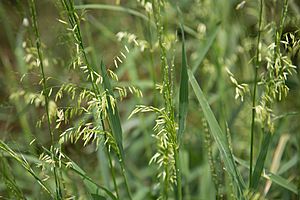Texas wild rice facts for kids
Quick facts for kids Texas wild rice |
|
|---|---|
 |
|
| Conservation status | |
| Scientific classification | |
| Genus: |
Zizania
|
| Species: |
texana
|
Texas wild rice (Zizania texana) is a very rare type of grass. It is only found in Texas, specifically in the upper part of the San Marcos River in Hays County. This special plant is in danger because its home is shrinking and getting damaged. It is officially listed as an endangered species in the United States.
Contents
What is Texas Wild Rice?
Texas wild rice is a type of aquatic plant, meaning it grows in water. It is related to the wild rice you might see in stores. This grass usually grows with only the tips of its stems sticking out of the water.
How Does it Look?
The stems of Texas wild rice can grow quite long, from 1 to 2 meters (about 3 to 6.5 feet). Some stems have even been found to be 5 meters (over 16 feet) long! Its leaves are like long ribbons, and they can be up to 1 meter (about 3 feet) long.
The plant has a flower cluster called an inflorescence, which looks like a feathery bunch. This cluster can be up to 31 centimeters (about 12 inches) long. The plant has separate male and female flowers on different parts of this cluster. The male flowers release pollen, which is carried by the wind to other plants.
How Does it Grow?
Texas wild rice can grow by making copies of itself, which is called cloning. Sometimes, these cloned stems grow together to form thick mats in the water.
Where Does Texas Wild Rice Live?
This unique plant lives in only one place: the first two miles of the San Marcos River in Texas. There are about 140 groups of stems in this area, covering about 1200 square meters (about 13,000 square feet).
There is also a group of these plants that were moved to Spring Lake, near the San Marcos Springs. Some plants are also kept safely at Texas State University.
Its Natural Home
The natural home for Texas wild rice is the clear water of the San Marcos River. This river gets its water from springs that come from the Edwards Aquifer. The grass needs very specific water conditions to grow well. This includes the right temperature, pH (how acidic or basic the water is), and turbidity (how clear the water is). It also needs certain water flow rates and types of river bottom.
Why is Texas Wild Rice Endangered?
Texas wild rice used to be very common in the San Marcos River. As recently as the 1930s, it grew so thick that it was sometimes a problem! But now, it is very rare.
Threats to its Survival
- Water Use: A big reason for its decline is that too much water has been taken from the Edwards Aquifer. This water is used for farming and other industries. When water is taken, the flow in the San Marcos River becomes lower, which hurts the plant.
- River Activities: People enjoying the river can also harm the plant. Activities like swimming or boating can break or bend the stems.
- Animal Threats: An animal called the nutria, which is an introduced species (meaning it's not naturally from the area), also threatens the plant.
- Floating Debris: Stems can get damaged or pushed underwater by trash or even by large clumps of other plants that are cut upstream and float down the river.
How Does Texas Wild Rice Reproduce?
Texas wild rice has a hard time making new plants through seeds. It rarely has successful sexual reproduction.
Pollen and Reproduction
- Pollen Release: The plant releases its pollen for only a short time each day, usually between 2 and 4 in the morning. Sometimes, it releases pollen again around 9 AM.
- Pollen Life: The pollen loses its ability to work very quickly, usually within a few minutes, and is completely useless within an hour.
- Wind Pollination: Since the wind carries the pollen, the flower cluster must be above the water. If the stem is broken or pushed underwater, the pollen cannot spread.
- Close Neighbors: Pollen usually travels less than one meter (about 3 feet) from its parent plant. This means plants need to be close together to reproduce. If they are too far apart, the pollen won't reach another flower.
- Fragmented Population: Because the plant is so rare and spread out now, it's hard for the pollen to find another flower that is ready to be pollinated.
- No Self-Pollination: The male flowers on one plant do not pollinate the female flowers on the same plant. This is because they don't release pollen at the same time the female flowers are ready.
Cloning and New Plants
The grass can also make new plants in another way: by producing tillers. Tillers are like new shoots that can break off and grow roots, forming a new stem. However, these new stems are exactly the same genetically as the parent plant.
Images for kids



